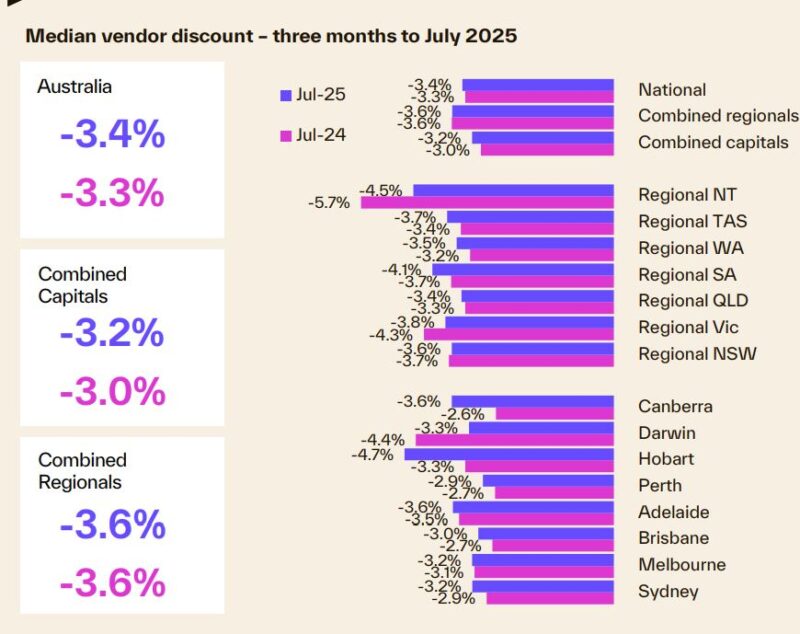
Key takeaways
Last week, the Reserve Bank of Australia implemented its third rate cut this year, and financial markets are predicting another two or three cuts by the middle of next year.
Peter Munton, Chief Economist at the Bank of Queensland, found that Australian home values generally increase by double digits within two years of the start of a rate-cutting cycle.
This is shown up over the weekend with preliminary auction clearance rates at almost boom time levels around Australia.
This week, Cotality also reports that:
*Sydney property prices increased 0.1% over the last week, increased 0.7% over the last month and are 1.8% higher than they were 12 months ago.
*Melbourne property prices increased 0.1% over the last week, increased 0.4% over the last month, and increased 1% compared to 12 months ago.
*Brisbane property prices increased 0.3% over the last week, increased 0.7% over the last month and are 7.3% higher than they were 12 months ago.
Overall, Australian capital dwelling prices increased 0.6% over the last month and are now 3.2% higher than they were 12 months ago.
There were 1,972 capital city homes taken under the hammer, the highest volume of auctions in seven weeks.
The combined capital’s preliminary auction clearance rate rising to 75.0%, 3.3 percentage points higher than the previous week
This current property cycle has been driven by an undersupply of good properties relative to current demand pushing up property values and rents there was nothing to suggest there will be any significant change in the near future.
Unfortunately, the undersupply properties is going to persist for some time with all commentators agreeing that there is no way we're going to hit the housing construction targets required to meet our demand.
Last week, the Reserve Bank of Australia delivered the third rate cut this year, and financial markets are forecasting another two or three rate cuts by the middle of next year.
Peter Munton, chief Economist at the Bank of Queensland, found that Australian home values typically rise by double-digit rates two years after the beginning of a rate-cutting cycle.
Apart from making property more affordable, the rate cut has already increased buyer and seller confidence.
And this is shown up over the weekend with preliminary auction clearance rates at almost boom time levels around Australia.
On the auction front this week... 1,972 capital city homes taken under the hammer, the highest volume of auctions in seven weeks.
The combined capital’s preliminary auction clearance rate rising to 75.0%, 3.3 percentage points higher than the previous week
This week, Cotality also reports that:
- Sydney property prices increased 0.1% over the last week, increased 0.7% over the last month and are 1.8% higher than they were 12 months ago.
- Melbourne property prices increased 0.1% over the last week, increased 0.4% over the last month, and increased 1% compared to 12 months ago.
- Brisbane property prices increased 0.3% over the last week, increased 0.7% over the last month and are 7.3% higher than they were 12 months ago.
Overall, Australian capital dwelling prices increased 0.6% over the last month and are now 3.2% higher than they were 12 months ago.
Clearly, the property cycle is moving on but our markets are very fragmented.
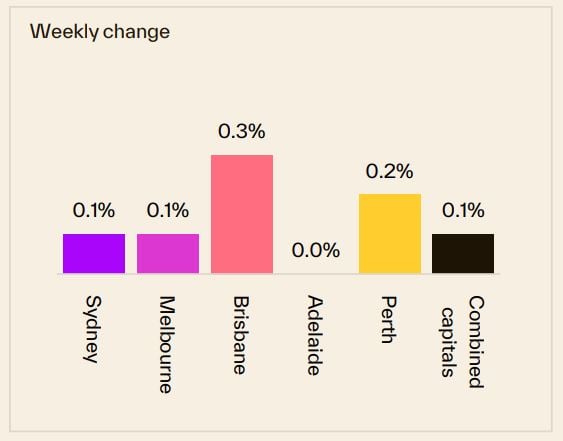
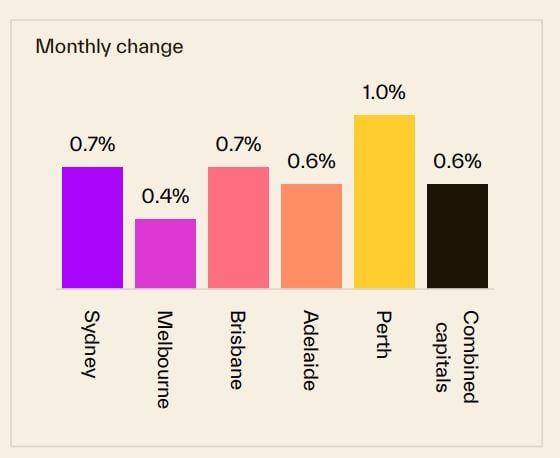
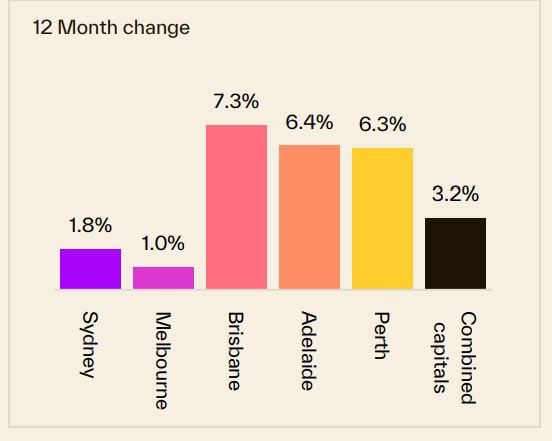
Source: Cotality August 18th 2025
Of course, these are "overall" figures - there is not one Sydney or Melbourne or Brisbane property market.
And various segments of each market are performing differently.
At the beginning of this cycle the upper quartile of the market lead the upswing but last year the lower quartile across every capital city recorded a stronger outcome for housing values relative to its upper quartile counterpart.
The following chart shows how various segments of each capital city market are performing differently with median-priced properties performing well.

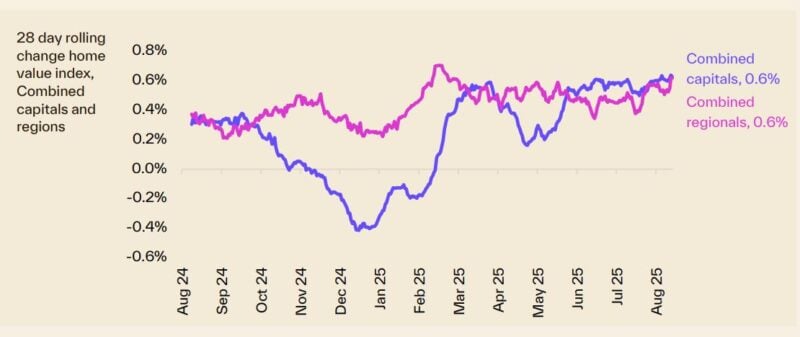
To help keep you up-to-date with all that's happening in property, here is my updated weekly analysis of data and charts as of 18th August 2025 provided by SQM Research, Cotality, and realestate.com.au.
Current property asking prices
Property asking prices are a useful leading indicator for housing markets - giving a good indication of what's ahead.
Here is the latest data available:
Sydney
| Property type | Price ($) | Weekly Change | Monthly Change % | Annual % change |
|---|---|---|---|---|
| All Houses | 2,026,512 | -11.112 | -1.3% | 6.4% |
| All Units | 872,294 | 1.406 | 1.8% | 6.2% |
| Combined | 1,556,317 | -6.013 | -0.6% | 6.1% |
Source: SQM Research
Melbourne
| Property type | Price ($) | Weekly Change | Monthly Change % | Annual % change |
|---|---|---|---|---|
| All Houses | 1,294,985 | 0.003 | -0.4% | 4.5% |
| All Units | 633,516 | 2.884 | 0.8% | 3.8% |
| Combined | 1,085,886 | 0.914 | -0.2% | 4.2% |
Source: SQM Research
Brisbane
| Property type | Price ($) | Weekly Change | Monthly Change % | Annual % change |
|---|---|---|---|---|
| All Houses | 1,262,986 | 3.404 | 1.0% | 11.0% |
| All Units | 747,003 | 3.497 | 1.7% | 16.3% |
| Combined | 1,133,174 | 3.427 | 1.1% | 11.7% |
Source: SQM Research
Perth
| Property type | Price ($) | Weekly Change | Monthly Change % | Annual % change |
|---|---|---|---|---|
| All Houses | 1,164,289 | 6.038 | 1.1% | 11.7% |
| All Units | 658,511 | 2.505 | 1.7% | 18.7% |
| Combined | 1,031,735 | 5.112 | 1.2% | 12.8% |
Source: SQM Research
Adelaide
| Property type | Price ($) | Weekly Change | Monthly Change % | Annual % change |
|---|---|---|---|---|
| All Houses | 1,042,994 | -5.637 | -1.3% | 11.9% |
| All Units | 561,581 | -2.381 | 0.0% | 19.9% |
| Combined | 956,372 | -5.051 | -1.1% | 12.7% |
Source: SQM Research
Canberra
| Property type | Price ($) | Weekly Change | Monthly Change % | Annual % change |
|---|---|---|---|---|
| All Houses | 1,042,994 | -5.637 | -1.3% | 11.9% |
| All Units | 561,581 | -2.381 | 0.0% | 19.9% |
| Combined | 956,372 | -5.051 | -1.1% | 12.7% |
Source: SQM Research
Darwin
| Property type | Price ($) | Weekly Change | Monthly Change % | Annual % change |
|---|---|---|---|---|
| All Houses | 798,311 | 0.589 | 1.4% | 22.6% |
| All Units | 434,920 | 2.580 | 3.7% | 14.7% |
| Combined | 655,470 | 1.372 | 2.0% | 20.4% |
Source: SQM Research
Hobart
| Property type | Price ($) | Weekly Change | Monthly Change % | Annual % change |
|---|---|---|---|---|
| All Houses | 844,971 | 4.574 | 0.4% | 7.5% |
| All Units | 496,490 | 0.910 | -0.3% | -0.6% |
| Combined | 791,851 | 4.015 | 0.4% | 6.6% |
Source: SQM Research
National
| Property type | Price ($) | Weekly Change | Monthly Change % | Annual % change |
|---|---|---|---|---|
| All Houses | 1,006,356 | -2.389 | -0.2% | 8.0% |
| All Units | 596,809 | 3.998 | 1.6% | 7.5% |
| Combined | 917,684 | -1.006 | 0.1% | 7.8% |
Source: SQM Research
Cap City Average
| Property type | Price ($) | Weekly Change | Monthly Change % | Annual % change |
|---|---|---|---|---|
| All Houses | 1,474,754 | -6.755 | -1.0% | 7.1% |
| All Units | 749,342 | 1.327 | 1.2% | 7.9% |
| Combined | 1,258,468 | -4.345 | -0.6% | 7.0% |
Source: SQM Research
The value of property asking prices as a leading indicator for housing markets is quite significant.
In fact it's more valuable than median prices which can be quite misleading.
Let's delve into why this is the case and how it impacts the real estate market.
- Early Market Sentiment Indicator: Asking prices often reflect the current sentiment of sellers in the real estate market.
If sellers are confident, they might set higher asking prices, anticipating strong demand.
Conversely, if sellers are uncertain or perceive a market downturn, they might lower their asking prices to attract buyers.
This makes asking prices a real-time indicator of market sentiment, often preceding changes in actual sales prices. - Predictive of Future Price Trends: Trends in asking prices can be predictive of where the actual property prices are headed.
For example, a consistent rise in asking prices over a period can signal an upcoming rise in transaction prices. - Impact of Economic Factors: Economic factors such as interest rates, employment rates, and broader economic health influence asking prices.
For instance, changes in the Reserve Bank of Australia's policies or shifts in the job market can quickly reflect in the asking prices, providing insights into how these factors are influencing the housing market. - Regional Variations: In a diverse market like Australia's, asking prices can also provide insights into regional disparities.
For instance, the property markets in Melbourne and Sydney might behave differently from those in Brisbane or Perth. Asking prices can give early indications of these regional trends. - Influence of Supply and Demand: Asking prices are also a response to the balance of supply and demand in the market.
In areas with limited supply and high demand, asking prices tend to be higher and vice versa.
However, it's important to note that while asking prices are a valuable indicator, they should not be used in isolation.
Other factors like actual sales prices, time on the market, auction clearance rates, and economic conditions also play crucial roles in understanding the property market dynamics.
READ MORE: The latest median property prices in Australia’s major cities
Last weekend's auction report
Auction market responds positively to August rate cut
The volume of auctions held last week leapt 24.3% relative to the week prior, with 1,972 capital city homes taken under the hammer, the highest volume of auctions in seven weeks.
The market has responded positively to the August rate cut, with the combined capital’s preliminary auction clearance rate rising to 75.0%, 3.3 percentage points higher than the previous week, and the highest early clearance rate since the first week of April last year (75.9%).
The lift in early success rates was broadbased, with every capital city recording a rise relative to the week prior.

There were 961 auctions held in Melbourne last week, the highest volume in seven weeks and a solid 29.5% jump on the volume of auctions held the previous week (742).
75.5% of auctions have been reported as successful so far, 4.6 percentage points higher than the week prior and the highest early result since the last week of July ‘25 when the preliminary clearance rate reached 76.3%.
Sydney hosted 720 auctions last week, a 29.5% jump relative to the week prior (556) and the highest weekly volume of auctions held since the last week of June (771).
75.0% of auctions were reported as sold based on the results collected so far, the highest preliminary result since the week ending July 13 and the third highest early result through the year-to-date.
In Brisbane, 137 auctions were held last week, up 10.5% from the previous week.
The preliminary clearance rate came in at 69.6%, up 2.6 percentage points on the week prior.
There were 90 homes auctioned in Adelaide last week with 78.0% so far reported as sold, the highest preliminary clearance rate since the last week of June (80.8%) and the third highest so far this year.
Canberra hosted 52 auctions last week, down slightly from the 57 held the previous week, with the preliminary clearance rate surging to the city’s highest since the first week of June last year at 80.6%.
In Perth, six of 11 auction results have been collected so far, three of which were successful.
There was one auction scheduled in Tasmania last week which was sold after auction.
Auction activity is set to rise further this week, with approximately 2,100 homes currently scheduled for auction, marking the first time the volume of capital city auctions has breached the 2,000 mark since the last week of June (2,044).
Our rental markets
According to Cotality, with rental vacancy rates holding close to historic lows,tracking at 1.7% nationally in July, there has been some evidence of reaccelerating growth trends.
On a seasonally adjusted basis, national rents were up 1.1% over the three months ending July, up from a recent low of 0.5% through the September quarter last year.
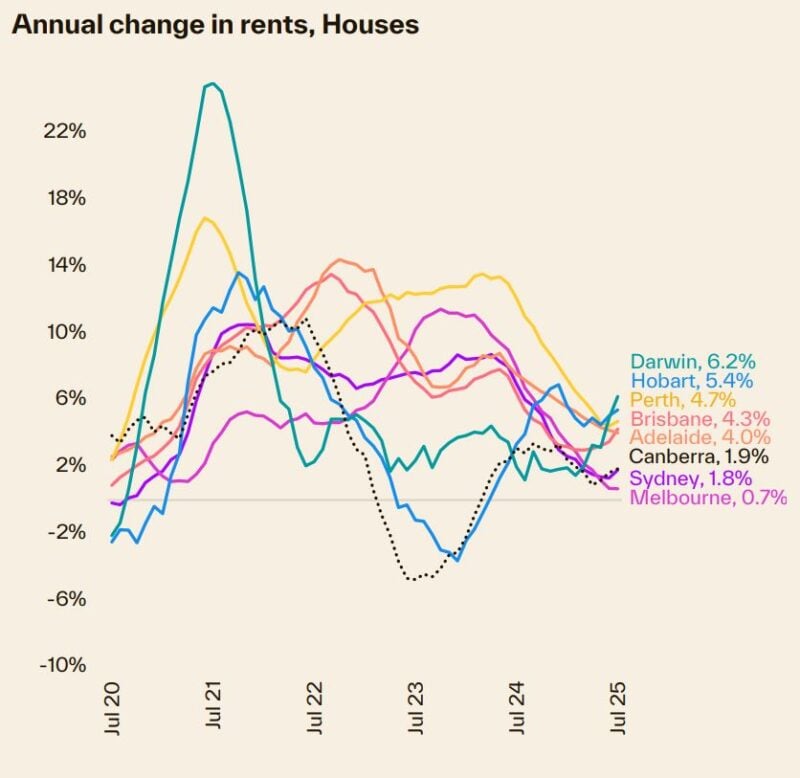
The unit sector has seen a stronger trend with seasonally adjusted rents up 1.3% over the past three months after dipping to a rolling quarterly change of just 0.5% through the end of last year.
However, growth in house rents has also picked up, rising to 1.1% after the three-month trend eased back to just 0.5% in Q3 last year.
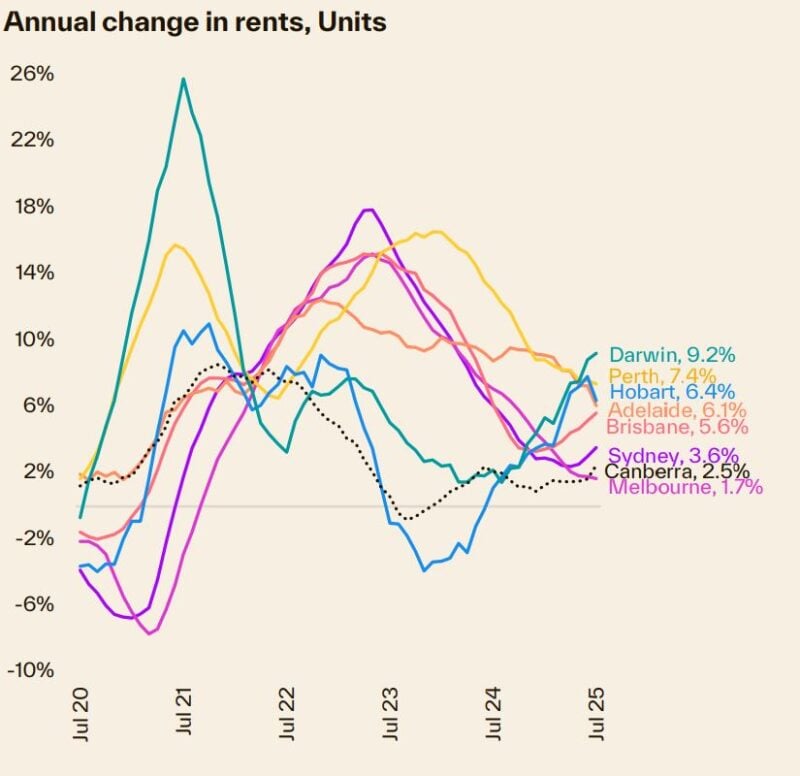
Although rental growth has picked up, gross rental yields edged lower in July, reducing to 3.68% nationally across all dwellings, down from 3.71% in April.
The highest capital city gross rental yields, by far, can be found in Darwin at 6.4%, a factor of relatively low purchase prices relative to rental income.

Sydney
| Property Type | Rent ($) | Weekly change | Monthly change | 12 Months change |
|---|---|---|---|---|
| All Houses | $1,076.91 | 0.09 | 0.6% | 5.1% |
| All Units | $710.98 | 1.02 | 1.2% | 2.5% |
| Combined | $859.38 | 0.64 | 0.9% | 3.8% |
Source: SQM Research
Melbourne
| Property Type | Rent ($) | Weekly change | Monthly change | 12 Months change |
|---|---|---|---|---|
| All Houses | $768.72 | 1.28 | 0.4% | 4.1% |
| All Units | $575.64 | 0.36 | 0.1% | 3.3% |
| Combined | $656.09 | 0.74 | 0.3% | 3.8% |
Source: SQM Research
Brisbane
| Property Type | Rent ($) | Weekly change | Monthly change | 12 Months change |
|---|---|---|---|---|
| All Houses | $766.79 | -3.79 | 0.7% | 4.8% |
| All Units | $611.46 | 3.54 | 1.7% | 6.6% |
| Combined | $696.86 | -0.49 | 1.1% | 5.5% |
Source: SQM Research
Perth
| Property Type | Rent ($) | Weekly change | Monthly change | 12 Months change |
|---|---|---|---|---|
| All Houses | $828.82 | -0.82 | -0.3% | 6.2% |
| All Units | $650.39 | -2.39 | -0.7% | 4.4% |
| Combined | $754.91 | -1.47 | -0.4% | 5.7% |
Source: SQM Research
Adelaide
| Property Type | Rent $) | Weekly change | Monthly change | 12 Months change |
|---|---|---|---|---|
| All Houses | $669.07 | -2.07 | -0.4% | 1.8% |
| All Units | $526.75 | 4.25 | -0.2% | 5.3% |
| Combined | $620.79 | 0.08 | -0.4% | 2.9% |
Source: SQM Research
Canberra
| Property Type | Rent ($) | Weekly change | Monthly change | 12 Months change |
|---|---|---|---|---|
| All Houses | $774.37 | -3.37 | 0.0% | -0.8% |
| All Units | $582.51 | -2.51 | -1.0% | 4.4% |
| Combined | $669.47 | -2.90 | -0.4% | 1.5% |
Source: SQM Research
Darwin
| Property Type | Rent ($) | Weekly change | Monthly change | 12 Months change |
|---|---|---|---|---|
| All Houses | $777.53 | -7.53 | 0.8% | 14.2% |
| All Units | $563.12 | 2.88 | 2.6% | 4.1% |
| Combined | $650.67 | -1.37 | 1.7% | 8.9% |
Source: SQM Research
Hobart
| Property Type | Rent 9$) | Weekly change | Monthly change | 12 Months change |
|---|---|---|---|---|
| All Houses | $583.31 | -1.31 | 2.0% | 9.2% |
| All Units | $503.32 | -0.32 | 1.2% | 8.8% |
| Combined | $551.37 | -0.92 | 1.7% | 9.1% |
Source: SQM Research
National
| Property Type | Rent ($) | Weekly change | Monthly change | 12 Months change |
|---|---|---|---|---|
| All Houses | $723.00 | 1.00 | 1.1% | 4.5% |
| All Units | $569.00 | 0.00 | 0.7% | 4.6% |
| Combined | $651.60 | 0.54 | 1.0% | 4.5% |
Source: SQM Research
Cap City Average
| Property Type | Rent ($) | Weekly change | Monthly change | 12 Months change |
|---|---|---|---|---|
| All Houses | $865.00 | -2.00 | 0.2% | 5.0% |
| All Units | $645.00 | 0.00 | 0.8% | 3.5% |
| Combined | $748.02 | -0.94 | 0.5% | 4.3% |
Source: SQM Research
Sellers of good properties are on strike
The flow of newly advertised listings has continued to track well below average (-8.8%) through July, with just 32,481 newly listed properties nationally over the four weeks to August 3rd.
Although we typically see fewer new listings thought winter, current numbers are -11.5% below the levels seen this time last year and are roughly in line (-0.4%) with those seen in 2020 amid covid lockdowns and viewing restrictions.
With the flow of newly advertised listings holding well below average, total stock levels have continued to decline, with properties being absorbed faster than they are added to the market.
Over the four weeks to August 3rd, Cotality observed 121,113 total listings nationally, -9.5% below the counts seen this time last year and -19.4% lower than the average levels usually seen this time of year.

Vendor metrics
As the following chart shows, it's taking longer to sell a home.
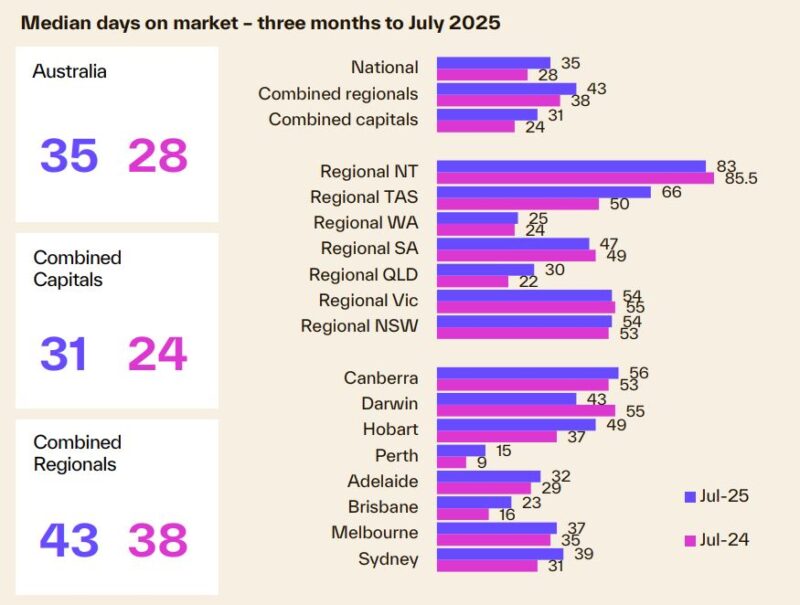
The national median time on market rose to 35 days over the three months to July after briefly dipping to 30 days over the three months to April.
Relative to this time last year, selling times have increased across all capitals except Darwin (43 days, down 12 days).
Hobart (49 days) saw the largest increase in median days on market, followed by Sydney (39 days) and Brisbane (23 days), up twelve, eight and seven days, respectively.
